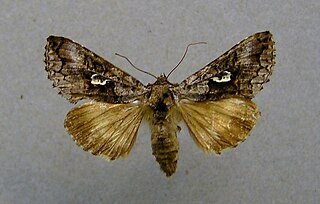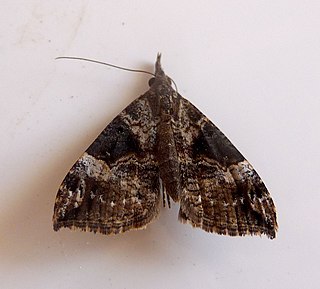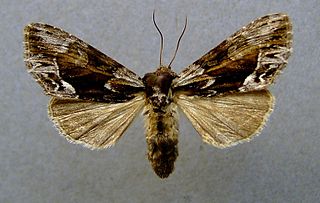
The small angle shades is a moth of the family Noctuidae. It is distributed throughout the Palearctic. The species was first described by Carl Linnaeus in his 1758 10th edition of Systema Naturae.

Apamea monoglypha, the dark arches, is a moth of the family Noctuidae. The species was first described by Johann Siegfried Hufnagel in 1766. It is a common, sometimes abundant, European species. It is found in most of Europe except northernmost Fennoscandia and the southern parts of the Iberian Peninsula and Greece. The species is also found in Anatolia, Turkestan, Western Asia and Central Asia, Siberia and Mongolia. In the Alps it is found up to heights of 2,500 meters. The smaller subspecies sardoa is found on Sardinia and Corsica.

Apamea crenata, known as the clouded-bordered brindle, is a moth in the family Noctuidae. It is distributed throughout the Palearctic realm. In the North it crosses the Arctic Circle, in the Mediterranean it is found only in cool locations and mountains avoiding very hot areas. In the Alps, it rises to an altitude of about 2000 metres.

Apamea remissa, the dusky brocade, is a species of moth of the family Noctuidae. It is distributed throughout Europe and Turkey, ranging across the Palearctic realm to Siberia, Manchuria and Japan. It has also been reported from Alaska.

Mythimna albipuncta, the white-point, is a moth of the family Noctuidae. The species was first described by Michael Denis and Ignaz Schiffermüller in 1775. It is distributed throughout Europe and one subspecies is found in Tunisia. It is also found in Asia Minor, Armenia, and Iran, and the northeastern United States.

Orthosia incerta, the clouded drab, is a species of moth of the family Noctuidae, found in Europe and Asia. The occurrence of the species extends through all European countries through the Palearctic to the Russian Far East and Japan. It is absent from northern Fennoscandia and in the Alps it occurs up to 2000 m above sea level.

Mormo maura, the old lady or black underwing, is a species of moth of the family Noctuidae. The species was first described by Carl Linnaeus in the 10th edition of his Systema Naturae. It is found in the Palearctic realm, from north-western Africa through all over southern Europe. It reaches its northern border in the west in northern Ireland and central Scotland, in central Europe, in northern Germany and Poland. In some Nordic countries, there are single finds. The other occurrence areas include Turkestan, Anatolia, the Middle East and Iraq. The name "old lady" refers to the fact that the wing pattern was said to resemble the shawls worn by elderly Victorian ladies.

Hoplodrina ambigua, the Vine's rustic, is a moth of the family Noctuidae. It is found in the western Palearctic realm.

Parapoynx stratiotata, the ringed china-mark, is a moth of the family Crambidae. The species was first described by Carl Linnaeus in his 1758 10th edition of Systema Naturae. It is found in Europe where the distribution area extends in the north to the British Isles including Ireland and in the south to Sardinia, Sicily and Greece. The species is also found across the Palearctic in North Africa, Lebanon, Turkey, Azerbaijan, Kyrgyzstan, Uzbekistan and China..

Noctua fimbriata, the broad-bordered yellow underwing, is a moth of the family Noctuidae. It is found in Europe, North Africa, Anatolia, the Caucasus, Turkey, Caucasus, Transcaucasia, Armenia, Turkmenistan and Novosibirsk Oblast. The border of its southern range is unclear because of the similar looking species Noctua tirrenica.

Anaplectoides prasina is a species of moth of the family Noctuidae. It is found in both the Palearctic and Nearctic realms.

Polia bombycina is a moth of the family Noctuidae. It is found in the Palearctic realm from Ireland to Japan including the Russian Far East and Siberia.

Carcina quercana is a species of moth of the family Depressariidae. It is found in Europe. It has been introduced recently in North America, British Columbia and western Washington. It is occasionally known by several common names including oak lantern, long-horned flat-body, and oak-skeletonizer moth.

Syngrapha interrogationis, the scarce silver Y, is a moth of the family Noctuidae. It is found in northern part of the world including Alaska, Canada, Iceland, Europe, Siberia, the Pacific Northwest region of the United States, and Northeast Asia.

Mesapamea secalis, the common rustic, is a moth of the family Noctuidae. The species was first described by Carl Linnaeus in his 1758 10th edition of Systema Naturae. It is found in Europe, north-west Africa, Turkey and northern Iran.

Lygephila craccae, the scarce blackneck, is a moth of the family Erebidae. It is found in temperate Europe and across the Palearctic to the Altai Mountains, Korea, Japan and China.

Hypena obsitalis, the Bloxworth snout, is a moth of the family Erebidae. It is found in the Mediterranean Basin including North Africa and in the Near East and Middle East, south up to the Sahara. Further north it is a migrant which occasionally establishes.

The lunar-spotted pinion is a moth of the family Noctuidae.

Hyppa rectilinea, the Saxon, is a moth of the family Noctuidae. It is found in Europe, but mostly in northern and central Europe. In the south, it is found in scattered populations, mainly in mountainous areas. To the east, its range stretches through northern Asia and eastern Siberia, up to the Pacific Ocean and Japan.
Polygrammodes supremalis is a moth in the family Crambidae. It was described by William Schaus in 1920. It is found in Paraná, Brazil.


















